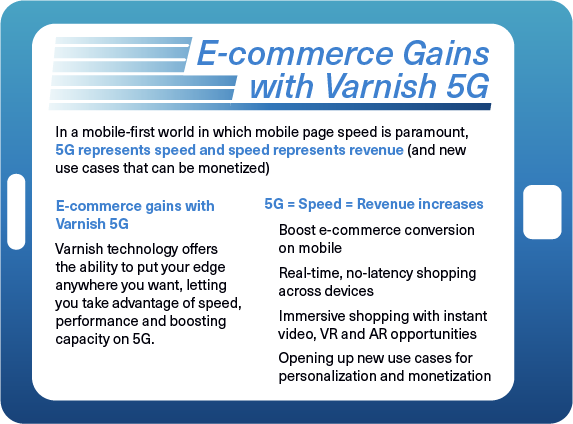E-commerce is poised to change in the near future, and while many predictions herald the coming of ubiquitous VR/AR and voice shopping, some of the changes are likely to be more fundamental and, at least at first, almost invisible.
To start with, the real change will happen at the technology level, driven by edge computing and the coming wave of 5G network deployments. With immediately speedier page loads and smoother, faster transactions on mobile, an immediate effect could be more mobile-first shopping and consumer conversion than ever before. And with that shift to mobile-dominant shopping, the whole e-commerce landscape begins to change.

What’s been holding mobile e-commerce back?
While more consumers have been using mobile for shopping, the stumbling block has often been making the final purchase on mobile. In Europe and the US, consumers use their mobile devices to do a lot of research and comparison shopping. With 5G, will this start to tip e-commerce toward becoming m-commerce?
While there are other factors (consumer trust, the smaller form factor making it harder to visualize merchandise, etc.), much of the delay has been performance related. Mobile page loads have been slower. Speed and ease of use determines the consumer experience. If pages load slowly, there is latency in moving from page to page, and capacity cannot be served, consumers will give up.
5G and edge computing to the rescue
5G delivers speed and performance and boosts capacity while virtually eliminating latency. The customer journey from entering the site to searching, browsing, adding to cart, and making purchases will become more straightforward and speedy. This is where the fundamental shift begins.
Because 5G and the edge, which ensures that content is sent from as close to the consumer as possible, interactions are nearly in real-time, which means that the long-promised truly personalized e-commerce experience can be realized, as consumer data and location-based targeting can be instantly fed back into the shopping experience, so retailers are able to engage, recommend, and upsell in equally real time. It may go beyond the customer-relationship building consumers are used to become a more interactive experience.
Performance enhancements and personalized experiences on mobile may help generate the nearly USD 12 billion in new mobile commerce revenue by 2021 that industry analysts predict.

The future of m-commerce
While it’s difficult to predict exactly what future-oriented e-commerce use cases will take off as mobile takes over, we have already seen an explosion in video-based commerce, both with live video shopping, which has become very popular during the Covid-19 crisis as people haven’t been able to shop in brick-and-mortar stores, and exclusive video events, such as those employed during China’s annual Singles Day event. 5G is also poised to revolutionize the video advertising industry.

There are also the edge cases that are currently possible in only select circumstances, but these may well take off mobile shopping changes. 5G stands to transform augmented and virtual reality, which will finally take e-commerce out of the one-dimensional world and put consumers into a richer, more interactive, three-dimensional experience with products of interest. AI is another potentially game-changing mobile e-commerce boon, referring back to the “interactive” experience, as consumer data generated can power real-time intelligence, making for a more personalized and immediate shopping experience.
/VS-logo-2020-197x60.png?width=136&height=60&name=VS-logo-2020-197x60.png)

